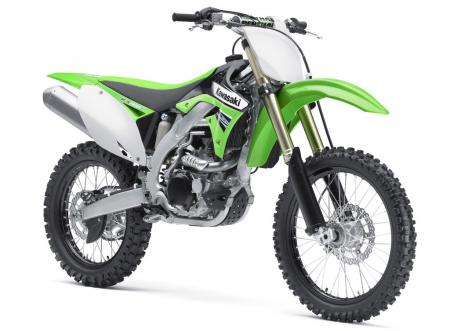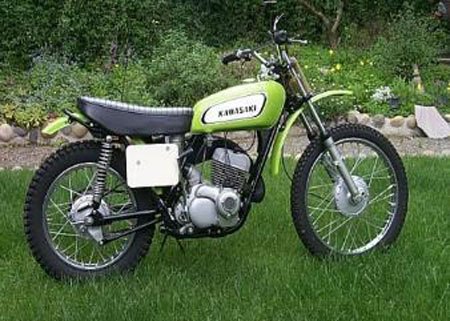 |
| Top 2013 Kawasaki KX450F Review - First Impressions |
And why not? The big KX was a fire breather and perhaps the easiest starting big-bore four-stroke MX bike on Earth. It carved up berms like salami, and made air time look like a Blue Angels show.
But perfection is an elusive goal, so the folks at Kawasaki made a host of revisions to the 2011 model;
 |
| Top 2013 Kawasaki KX450F Review - First Impressions |
Like last year’s bike, Kawasaki suggests a leak-down test be done after ten hours of hard riding. All that horsepower needs to be maintained. We spoke with a rider at the press intro who campaigned a 2010 KX450F last season, and he relayed that even after 18 hours on the motor, the top end was still tight, and he only had to adjust the valves once. Good news for the Kawasaki four-stroke crowd.
A 43mm throttle body holds an ultra-fine atomizing injector, set at a 45-degree angle for good midrange and top-end power, via a 12-hole system that sprays the fuel in at 60-micron particles, allowing for smooth and accurate power delivery throughout the rev range.
Kawasaki also improved the transmission by incorporating a larger internal roller on the shift cam, and a stronger shift-return spring for more positive shifts, something our tester complained about on last year’s model.
Kawi also dialed in more flex in the aluminum chassis by incorporating steel versus aluminum mounting brackets for the motor. The piston crown has been redesigned to go with the larger high-volume muffler, along with a longer and hotter spark from the programmable ECU.
 |
| Top 2013 Kawasaki KX450F Review - First Impressions |
Suspension has been modified to provide a supple ride over braking bumps, with damping settings matched to provide a smooth works-like ride for the aggressive rider. The 2011 KX has a D-shaped aluminum swingarm that features a cross section of narrow ribs and thin-wall construction. It pivots high in the frame to increase rear-wheel hook-up. Mounting the rocker-arm of the Uni-Trak rear suspension linkage below the swingarm pivot provides a longer rear suspension stroke and allows for easier shock tuning.
Keeping current on the latest technology, the fork received the slippery DLC (Diamond-Like Carbon) treatment to the outer surfaces of the inner fork tube. This minimizes stiction when the fork is exposed to side loads that would otherwise restrict the action. The suspension is very smooth due to a friction-reducing treatment Kawasaki calls “the Kashima Coat Treatment” on the inside of the forks tubes where all that damping and spring stuff is bouncing around. Also, the fork is a Kayaba Air-Oil-Separate unit that reduces frothing of the fork oil, which makes the fork handle rutted corners without pounding the rider’s forearms, a minor niggle on last year’s big KX.
The rear shock wasn’t ignored and also gets the Kashima treatment with a larger 50mm piston, and more accessible high- and low-speed compression adjuster knobs. The shock also got a revised damping and spring rate to allow for a plush feel throughout the changes in track conditions.
The KX sports a narrow mid-section on top, with a firm urethane foam saddle with a non-slip surface to provide grip when standing. The KX gets wider at the bottom of the frame to provide the rider with better control. The 50mm-wide pegs offer superb grip and give the pilot a comfortable platform to work from.
| Kawasaki’s MX History What came before the KX450F? | |||
| Story and photos by Matt Cuddy While we ooh and ahhhh at the newest technological marvel that is the 2011 KX450F, let’s take a look at what Kawasaki built way back when. One thing they all shared was big power. Seems Kawasaki has that horsepower thing down, even now. One of Kawasaki’s first forays into the world of motocross and scrambles was the 238cc Greestreak, a rotary-valved, open-piped beastie that was a screamer. It looked pretty damn nice, too. Many the Husky and Maico rider was put to the test as the Greenstreak whooshed by, throwing up a roost from the 30-plus-horsepower two-stroker. Kawasaki produced the ‘Streaks from 1968 to 1971. They were very light and powerful. Now considered a classic, they bring big money ion the vintage scene. Kawasaki upped the displacement in 1972 to 247cc and rebadged it the F81M, but it was still called a Greenstreak, with the rotary valve and open pipe. Kawasaki kept these around until 1974, when the first KX motocross series came out.
| |||
 |
| Top 2013 Kawasaki KX450F Review - First Impressions |
 |
| Top 2013 Kawasaki KX450F Review - First Impressions |
 |
| Top 2013 Kawasaki KX450F Review - First Impressions |
Now there are a lot of Kawasaki dirt bikes we missed (on purpose) but the ones that we chose, we figure were the ones that made history for Kawasaki, and set them up in the industry as a major player in all things fast and green.
As you can tell with this press- intro report on the 2011 KX450F, Kawi hasn’t lost any ground in that area. Kawasaki still hauls the coal and is on top of the horsepower game.
Now that we got all the tech stuff out of the way, it’s time for our test rider, Greg Jones (son of the legendary Gary Jones), to slide into the saddle and give us his impressions of the 2011 Kawasaki KX450F.
 |
| Top 2013 Kawasaki KX450F Review - First ImpressionsAdd caption |
We asked Greg to do things that any normal MX racer wouldn’t do, like go into a corner a gear or two higher, and pull it out at low revs. We wanted him to make the bike fail in one way or the other by abusing the transmission, clutch, brakes and motor. Greg did what we asked, but he said the bike didn’t mind the abuse and pulled out without a bobble or complaint.
After getting feedback on the 2010 model, it looks like Kawasaki listened, because the 2011 KX450F is a vastly improved machine over the 2010 motorcycle. No more shifting problems, no harsh fork action, brake fade or funny belching-popping noises out of the motor under load.
The bike rips, and we asked Greg straight out if it was as fast as his CRF450 Honda. After hemming and hawing around, Greg said “yes”.
After the ride part was over, and we’re sitting around bench racing, it came down to the last two questions.
We asked Greg what he thought the worst thing about the new Kawasaki was. He replied, “The front end washes out on hard-packed corners if there’s no berm or rut to catch the wheel.” This was backed up by a few other test riders sitting at our table. So you have to steer it with the throttle on hard-packed corners that have no berm or rut. Maybe a new type of front tire, like an intermediate M21 Dunlop, would have helped. But we didn’t get to explore that possibility.
 |
| Top 2013 Kawasaki KX450F Review - First Impressions |
And after seeing and hearing the new KX450F in action, I can only agree. It not only sounds better, because of the larger silencer, but seems to track straighter through snotty terrain. Looks like all that work paid off, because everybody at the press intro, from riders to writers, thought the same thing: the bike is a winner.
 |
| Top 2013 Kawasaki KX450F Review - First Impressions |


No comments:
Post a Comment